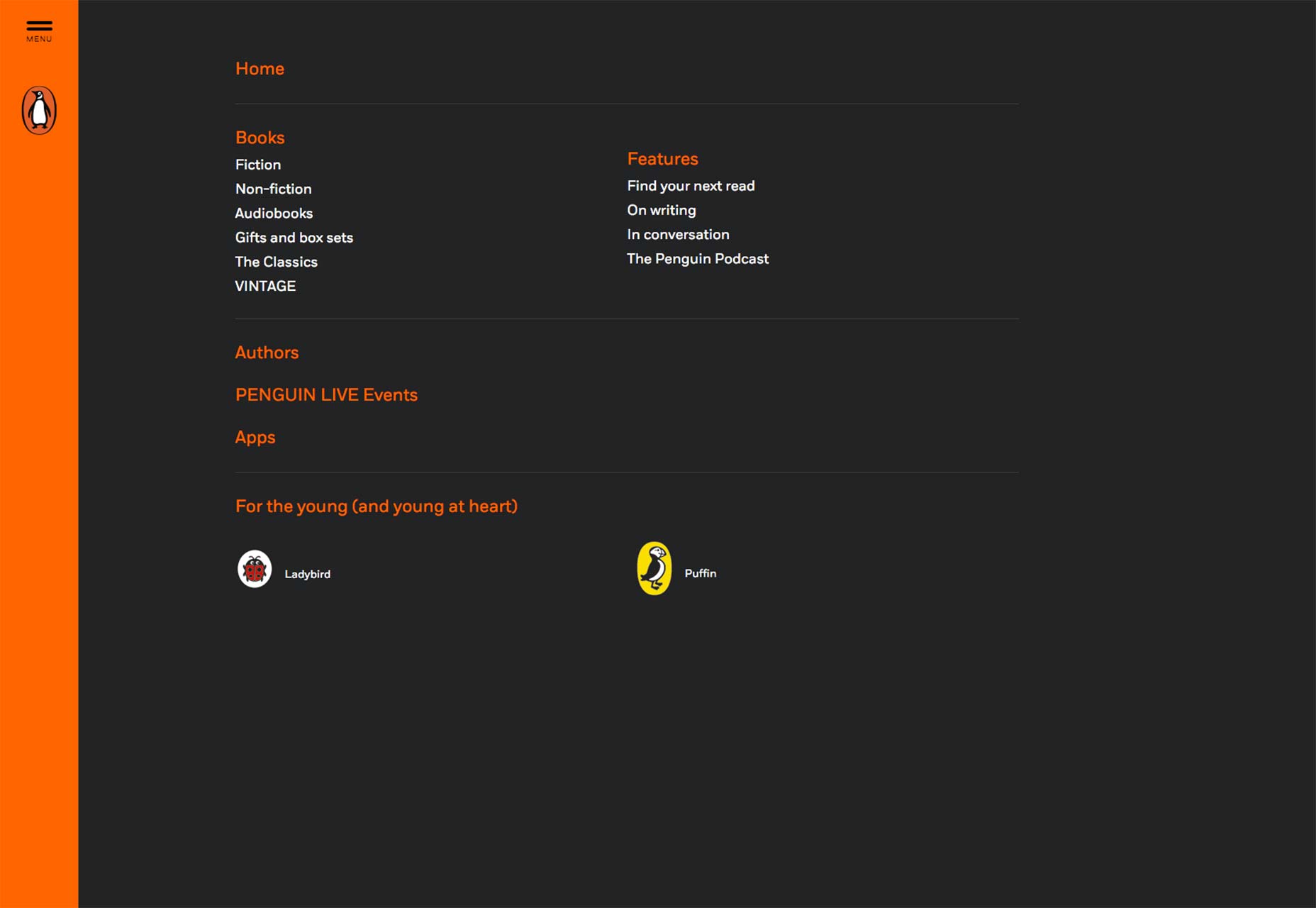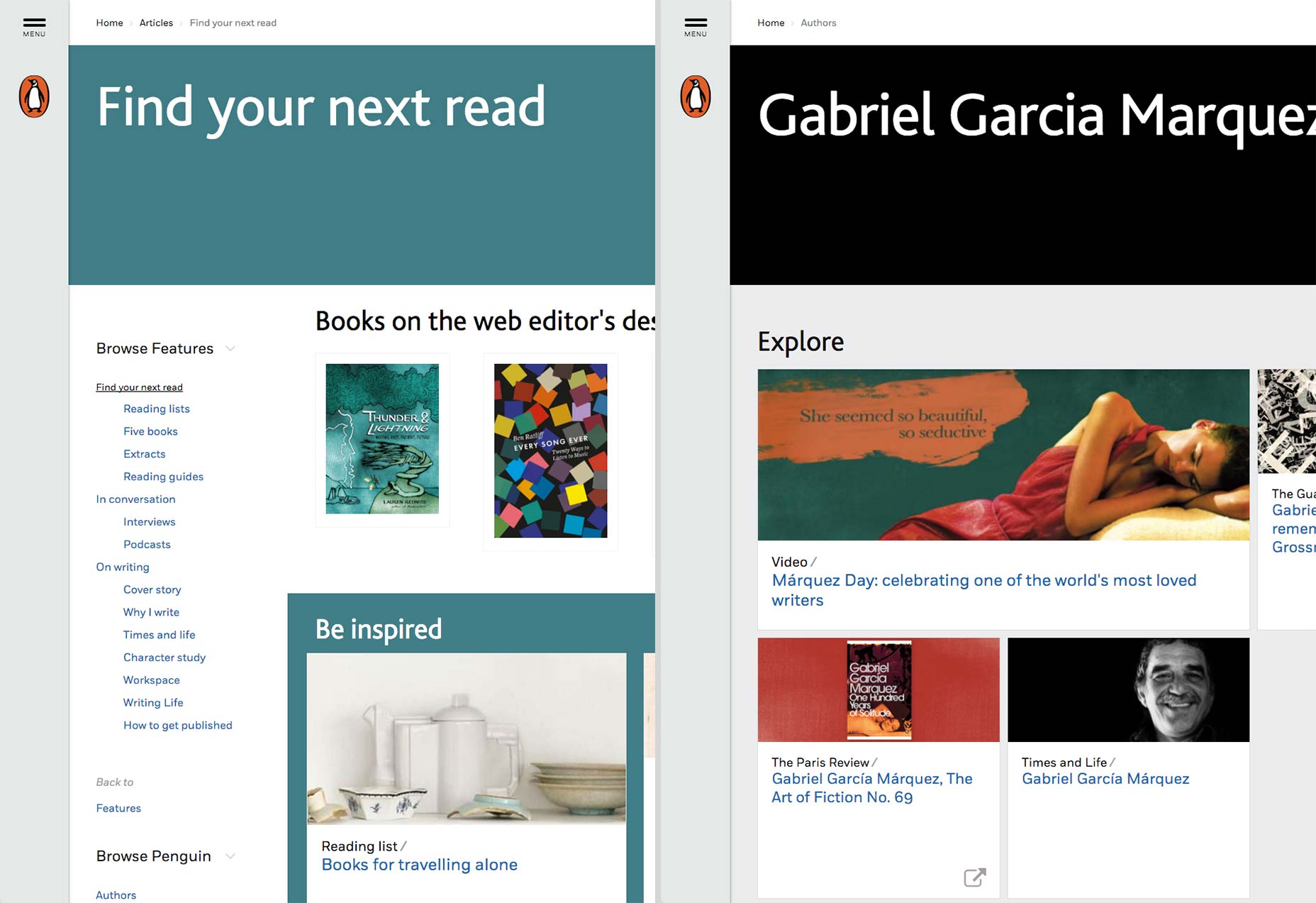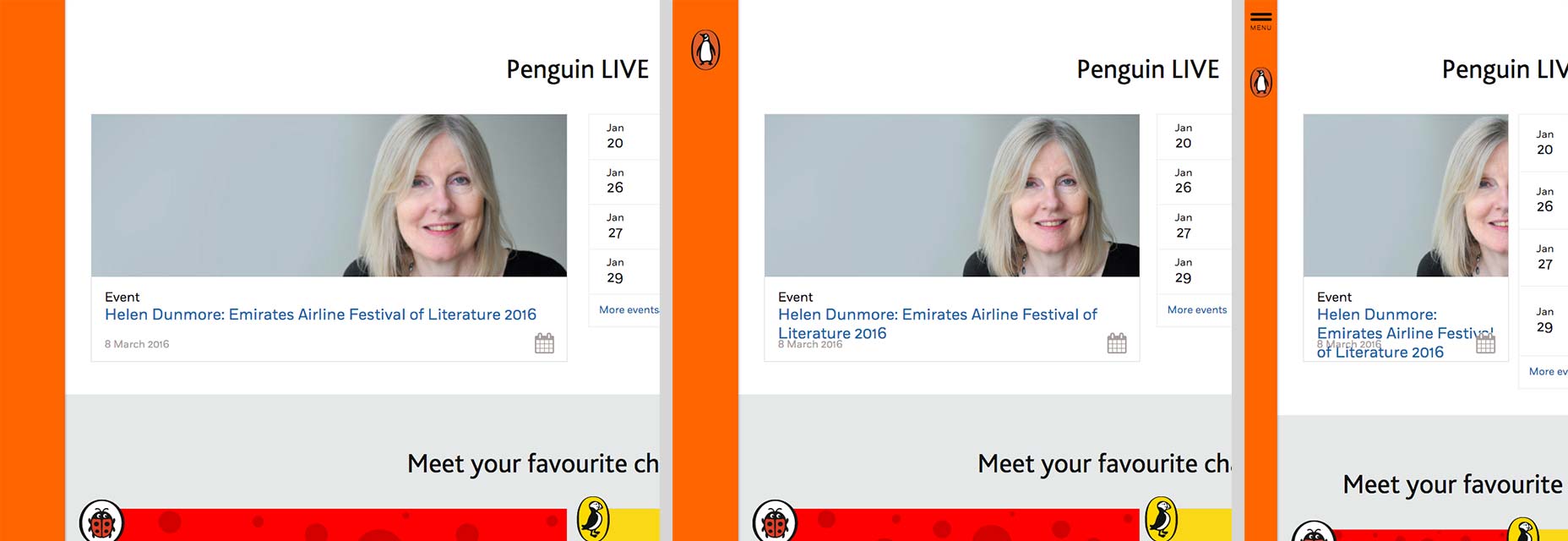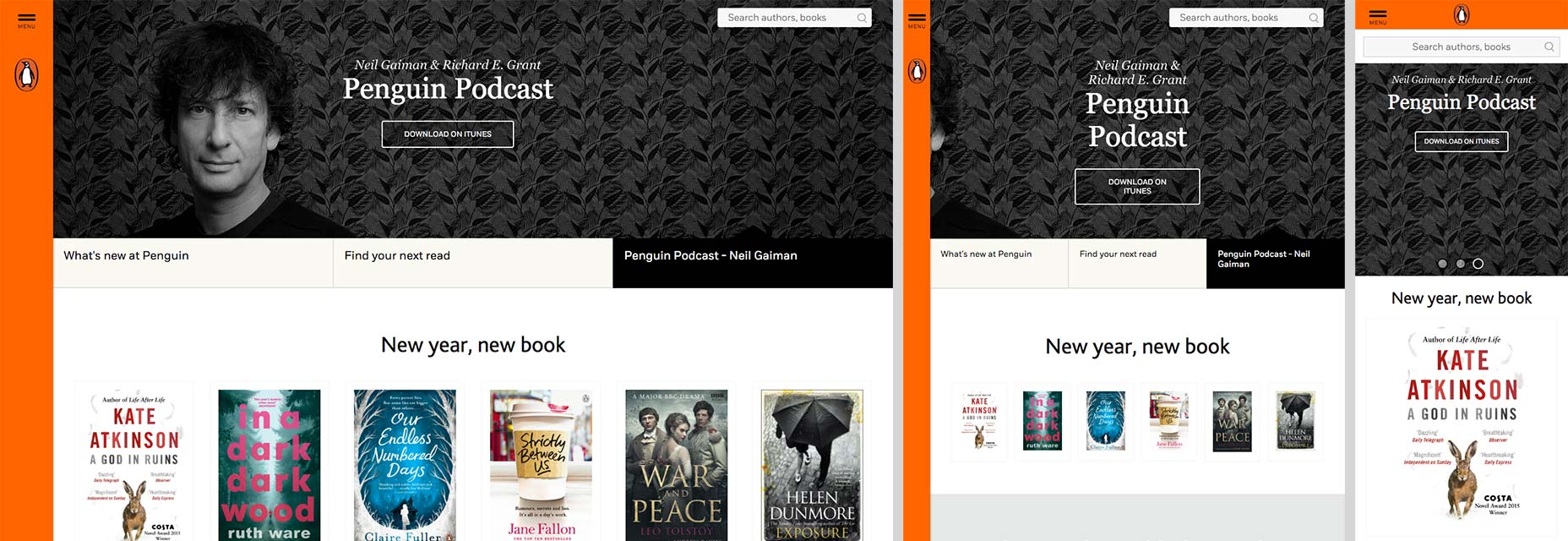
 Penguin Random House’s relaunched websites; for consumers (top) and for business (bottom).
Design Week reports that PRH carried out research via its ‘consumer insights panel’ with up to 3,000 customers, including 200 face-to-face conversations. This led them to conclude that the primary goal of readers visiting the site was “to get closer to the authors and characters they love.”
As a result of this insight, the new consumer site focuses heavily on quality content, with writer profiles of authors such as Nick Hornby, and F. Scott Fitzgerald; and interactive content, such as podcast interviews with the likes of Neil Gaiman, and Elvis Costello.
Both sites are, as you’d expect, fully responsive. And the mobile sizes in particular are an excellent example of how to organize a lot of content in a small viewport. However, whether due to mis-communication between different agencies, or due to a tight build time—reportedly just 12 weeks—there are a number of issues that seriously compromise the site’s UX.
One of the Penguin brand’s most distinct signifiers is the bright orange spine on its books, which has been deftly employed on the consumer site as a navigation bar — vertical on the left for large screens, horizontal at the top for smaller screens. It uses a hamburger menu, even on desktop, to give quick access to links; the saving grace (for those that hate hamburgers) being that the links that are obfuscated are largely surplus to requirements, the site’s primary navigation being inline links.
Penguin Random House’s relaunched websites; for consumers (top) and for business (bottom).
Design Week reports that PRH carried out research via its ‘consumer insights panel’ with up to 3,000 customers, including 200 face-to-face conversations. This led them to conclude that the primary goal of readers visiting the site was “to get closer to the authors and characters they love.”
As a result of this insight, the new consumer site focuses heavily on quality content, with writer profiles of authors such as Nick Hornby, and F. Scott Fitzgerald; and interactive content, such as podcast interviews with the likes of Neil Gaiman, and Elvis Costello.
Both sites are, as you’d expect, fully responsive. And the mobile sizes in particular are an excellent example of how to organize a lot of content in a small viewport. However, whether due to mis-communication between different agencies, or due to a tight build time—reportedly just 12 weeks—there are a number of issues that seriously compromise the site’s UX.
One of the Penguin brand’s most distinct signifiers is the bright orange spine on its books, which has been deftly employed on the consumer site as a navigation bar — vertical on the left for large screens, horizontal at the top for smaller screens. It uses a hamburger menu, even on desktop, to give quick access to links; the saving grace (for those that hate hamburgers) being that the links that are obfuscated are largely surplus to requirements, the site’s primary navigation being inline links.
 Unfortunately the navigation is not as intuitive as it could (or should) be. The Explore our world banner that greets you when you arrive on the site features a number of speech bubbles with labels such as “Reading lists”, “Meet our authors”, and “Q&As”, there is even a play video button; the lack of a conventional menu means that these labels look for all the world like links, but they are not.
Navigation continues to be an issue as you move deeper into the site. If for example you click the Find your next read link, the breadcrumb navigation (which transforms to a select input for mobile) reads Home > Articles > Find your next read, with the first two acting as links. However, if you navigate to a writer’s profile the breadcrumbs read Home > Authors, with only the former acting as a link. To return to the authors’ page and select a different writer’s profile, you must first return to the Home, and then navigate back to the Authors, and finally the author profile; or rely on the browser’s back button. It’s a small usability issue that really should have been picked up at the quality assurance stage, and suggests that the 12 week build may have been a shade too ambitious.
Unfortunately the navigation is not as intuitive as it could (or should) be. The Explore our world banner that greets you when you arrive on the site features a number of speech bubbles with labels such as “Reading lists”, “Meet our authors”, and “Q&As”, there is even a play video button; the lack of a conventional menu means that these labels look for all the world like links, but they are not.
Navigation continues to be an issue as you move deeper into the site. If for example you click the Find your next read link, the breadcrumb navigation (which transforms to a select input for mobile) reads Home > Articles > Find your next read, with the first two acting as links. However, if you navigate to a writer’s profile the breadcrumbs read Home > Authors, with only the former acting as a link. To return to the authors’ page and select a different writer’s profile, you must first return to the Home, and then navigate back to the Authors, and finally the author profile; or rely on the browser’s back button. It’s a small usability issue that really should have been picked up at the quality assurance stage, and suggests that the 12 week build may have been a shade too ambitious.
 Breadcrumbs working correctly (left) and breadcrumbs only linking to the home page (right).
Further evidence of a rushed launch can be seen in the “Penguin LIVE” section of the home page. Clearly no one anticipated an event title as long as “Helen Dunmore: Emirates Airline Festival of Literature 2016” because while it works at desktop sizes, and it works on mobile, the line height breaks at some medium sizes, and at others the content in the box breaks altogether. It feels very much like the kind of error that crops up when there’s a mismatch between the anticipated content, and the actual content the client types into their shiny new CMS.
Breadcrumbs working correctly (left) and breadcrumbs only linking to the home page (right).
Further evidence of a rushed launch can be seen in the “Penguin LIVE” section of the home page. Clearly no one anticipated an event title as long as “Helen Dunmore: Emirates Airline Festival of Literature 2016” because while it works at desktop sizes, and it works on mobile, the line height breaks at some medium sizes, and at others the content in the box breaks altogether. It feels very much like the kind of error that crops up when there’s a mismatch between the anticipated content, and the actual content the client types into their shiny new CMS.
 Content breaking down before a media query kicks in and resorts the screen for mobile-specific sizes.
Another issue is that the site’s responsive layout is not matched by much of the artwork. The banner advertising a podcast interview between Neil Gaiman and Richard E. Grant features a portrait of the author. On mobile it becomes a shot of slightly gothic wallpaper, but at certain tablet sizes it’s a shot of a disembodied ear. background-position is not an advanced concept these days — in fact top left is the default behaviour, so someone broke this on purpose; again, it seems that either the CMS has been built without the flexibility to handle multiple artwork alignments, or no one has trained the content producers how to use it.
Content breaking down before a media query kicks in and resorts the screen for mobile-specific sizes.
Another issue is that the site’s responsive layout is not matched by much of the artwork. The banner advertising a podcast interview between Neil Gaiman and Richard E. Grant features a portrait of the author. On mobile it becomes a shot of slightly gothic wallpaper, but at certain tablet sizes it’s a shot of a disembodied ear. background-position is not an advanced concept these days — in fact top left is the default behaviour, so someone broke this on purpose; again, it seems that either the CMS has been built without the flexibility to handle multiple artwork alignments, or no one has trained the content producers how to use it.
 Neil Gaiman (left), an ear (center), spooky gothic wallpaper (right).
For designers, one of the most interesting aspects of the redesign is being able to compare and contrast the B2C consumer site with the B2B corporate site. The latter has subtler branding, more subdued typography, and its tone is far more businesslike. It’s less flawed than the consumer site, principally because it’s less ambitious.
What’s most successful about the PRH relaunch sites, especially the consumer site, is that at no point do you feel like you are being sold anything. It’s structured to encourage exploration and discovery; it trusts that the books, from which the publisher makes its money, will sell themselves.
Sadly, the joy of immersion in some excellent content, is too often jarred by small oversights in the UI; oversights that realistically could be fixed in an afternoon.
Of course it’s impossible to draw conclusions about a site design process the history of which we’re not directly party to. We don’t know how cooperative (or otherwise) the client was, how high the budget was, exactly what was stipulated in the brief. If we recognize that Dribbble shots are particularly easy to produce, then conversely we have to acknowledge that real builds are tough. That said, this feels like a site that needed a fraction more attention to detail.
This is a site that book lovers can get lost in; just not necessarily in the way they would like.
Neil Gaiman (left), an ear (center), spooky gothic wallpaper (right).
For designers, one of the most interesting aspects of the redesign is being able to compare and contrast the B2C consumer site with the B2B corporate site. The latter has subtler branding, more subdued typography, and its tone is far more businesslike. It’s less flawed than the consumer site, principally because it’s less ambitious.
What’s most successful about the PRH relaunch sites, especially the consumer site, is that at no point do you feel like you are being sold anything. It’s structured to encourage exploration and discovery; it trusts that the books, from which the publisher makes its money, will sell themselves.
Sadly, the joy of immersion in some excellent content, is too often jarred by small oversights in the UI; oversights that realistically could be fixed in an afternoon.
Of course it’s impossible to draw conclusions about a site design process the history of which we’re not directly party to. We don’t know how cooperative (or otherwise) the client was, how high the budget was, exactly what was stipulated in the brief. If we recognize that Dribbble shots are particularly easy to produce, then conversely we have to acknowledge that real builds are tough. That said, this feels like a site that needed a fraction more attention to detail.
This is a site that book lovers can get lost in; just not necessarily in the way they would like.
Ben Moss
Ben Moss has designed and coded work for award-winning startups, and global names including IBM, UBS, and the FBI. When he’s not in front of a screen he’s probably out trail-running.
Read Next
3 Essential Design Trends, November 2024
Touchable texture, distinct grids, and two-column designs are some of the most trending website design elements of…
20 Best New Websites, October 2024
Something we’re seeing more and more of is the ‘customizable’ site. Most often, this means a button to swap between…
Exciting New Tools for Designers, October 2024
We’ve got goodies for designers, developers, SEO-ers, content managers, and those of you who wear multiple hats. And,…
15 Best New Fonts, September 2024
Welcome to our roundup of the best new fonts we’ve found on the web in the previous four weeks. In this month’s edition…
By Simon Sterne
3 Essential Design Trends, October 2024
This article is brought to you by Constantino, a renowned company offering premium and affordable website design
You…
A Beginner’s Guide to Using BlueSky for Business Success
In today’s fast-paced digital world, businesses are always on the lookout for new ways to connect with their audience.…
By Louise North
The Importance of Title Tags: Tips and Tricks to Optimize for SEO
When it comes to on-page SEO, there’s one element that plays a pivotal role in both search engine rankings and user…
By Simon Sterne
20 Best New Websites, September 2024
We have a mixed bag for you with both minimalist and maximalist designs, and single pagers alongside much bigger, but…
Exciting New Tools for Designers, September 2024
This time around we are aiming to simplify life, with some light and fast analytics, an all-in-one productivity…
3 Essential Design Trends, September 2024
September's web design trends have a fun, fall feeling ... and we love it. See what's trending in website design this…
Crafting Personalized Experiences with AI
Picture this: You open Netflix, and it’s like the platform just knows what you’re in the mood for. Or maybe you’re…
By Simon Sterne
15 Best New Fonts, August 2024
Welcome to August’s roundup of the best fonts we’ve found over the last few weeks. 2024’s trend for flowing curves and…
By Ben Moss















